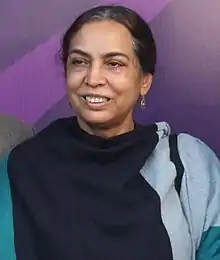Arpana Caur
Arpana Caur is a leading Indian contemporary painter and graphic artist.[1]
Arpana Caur | |
|---|---|
 | |
| Nationality | Indian |
| Known for | Painting |
| Parent(s) |
|
Early life and education
Arpana Caur was born in 1954, in Delhi. She comes from a Sikh family who fled the Pakistani West Punjab to the Republic of India in 1947 during the confusion over the partition of British India. Her mother Ajit Kaur (born in 1934), is a writer who writes in Panjabi. Kaur or Caur (pronunciation kor) is a religious surname worn by all female Sikhs. She has not had her first name Arpana since her birth, but she adopted it at the age of fifteen, as an expression of a personal development process.[2]
Her exposure to art, music and literature happened early in her life. She learnt the Sitar, wrote poetry but enjoyed painting the most. At the age of nine, she made her first oil painting, 'Mother & Daughter' inspired by the works of Amrita Shergil. Arpana graduated from the University of Delhi with a Master of Arts degree in Literature. She never received formal training in painting, and was largely self taught. She proceeded to receive training in the etching technique at the Garhi Studios in New Delhi, completing it in 1982.[2][3]
Career
Influences and style
Arpana Caur's paintings were shaped by the events and situations around her. Her mother's strong influence on her extended into her works; where the 'woman' often occupies a central focus. Her works are also inspired by Pahari miniatures (hill-paintings), Punjabi literature, and Indian folk art.[4]
'Spirituality' , and 'Time' are recurring themes in her works.
In the 1990s, Caur created a series of collaborations with Indian folk artists from the indigenous ethnic groups of Warli and Godna, who lived in the Madhubani region of the Indian state of Bihar.[5] She remains to be one of the first contemporary artists to have collaborated with folk artisans.
In 1994 she was commissioned a large work by the Hiroshima Museum of Modern Art to create a mural to mark the 50th anniversary of the bombings.[4]
Group exhibitions
1988 Graven Images[6]
1988 Numaish Lait Kala[6]
1992 Crossing Black Waters[6]
1995 Inside Out: Contemporary Women Artists of India, Middlesbrough Art Gallery[6]
Reviews, articles texts &c.
Eddie Chambers, ' Inside Out: Contemporary Women Artists of India', Art Monthly no193, (February1996) 35-37.[6]
Awards and honours
All India Fine Arts Society Award, 1985[4]
Gold Medal at 6th India Triennale 1986 (awarded by the Lalit Kala Akademi)[4]
Collections
Victoria and Albert Museum London
Rockefeller Collection, New York
Museum of Contemporary Art, Los Angeles
Singapore Art Museum, Singapore
National Gallery of Modern Art, New Delhi
Social consciousness
Arpana Caur has been leading the Academy of Fine Arts & Literature which hosts the South Asian Literature Festival; strengthening bonds between authors from the subcontinent.[8]
She is known to have successfully rallied against the felling of trees in New Delhi's Siri forest area during the construction of food courts / restaurants for the 2010 Commonwealth Games Village.[9]
She supports a leprosy home in Ghaziabad, setup in the memory of her younger sister. The home also offers vocational training for young girls.[10]
References
- "India Art Festival is now bigger and better". Millennium Post. 21 November 2017. Retrieved 25 November 2017.
- "Arpana Caur - SikhiWiki, free Sikh encyclopedia". www.sikhiwiki.org. Retrieved 26 November 2017.
- KG Saur. Volume 17. Munich: General Artist's Encyclopedia. 1997. p. 342.
- Mehrotra, Rajiv (2011). The Spirit of the Muse: Conversations on the Journeys of Artists. Hay House, Inc. ISBN 9789381398173.
- Jhaveri, Amrita (2005). A Guide to 101 Modern & Contemporary Indian Artists. Mumbai: India Book House. p. 101. ISBN 81-7508-423-5.
- Keen, Melanie. (1996). Recordings : a select bibliography of contemporary African, Afro-Caribbean and Asian British art. Ward, Elizabeth., Chelsea College of Art and Design., Institute of International Visual Arts. London: Institute of International Visual Arts and Chelsea College of Art and Design. ISBN 1899846069. OCLC 36076932.
- "Threads of Life: Arpana Caur's journey of becoming an artist living through violence". The Indian Express. 13 November 2016. Retrieved 30 March 2019.
- "Ties That Bind". The Indian Express. 9 October 2018. Retrieved 30 March 2019.
- Chowdhury, Kavita (23 October 2015). "Lunch with BS: Arpana Caur". Business Standard India. Retrieved 30 March 2019.
- Madhukar, Jayanthi (12 November 2016). "Artist Arpana Caur talks about her canvasses and what inspired them". The Hindu. ISSN 0971-751X. Retrieved 30 March 2019.